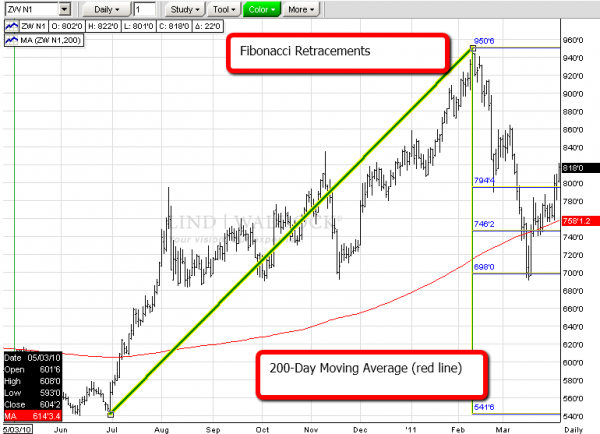Spring is here, and the agricultural markets kicked off a long season of reports as we head into growing season. On March 31, the United States Department of Agriculture (USDA) released its quarterly grain stocks and prospective plantings report. The numbers showed that corn and soybeans stocks are some of the tightest in our history.
U.S. corn stockpiles were reported at 6.52 million bushels at the beginning of March, soybean stockpiles were at 1.25 billion bushels, and wheat stockpiles were reported at 1.42 million bushels. The amount of acres that will be needed to build the stocks enough to meet high expected demand fell short of what will suffice.
The markets opened for the trading session after the report with a barrage of buying. May corn futures traded up their 30 cent limit to close at $6.9325 a bushel, and since then, have extended gains to above $7.50, the highest level since 2008.
While corn is leading the bull charge, soybeans and wheat have moved higher as well. The report on wheat in the U.S. was not quite as exciting as the other grains for the bull camp, but it did benefit from their accelerated upside moves. I think it may continue to do so as weather reports are warning of possible early flooding in areas responsible for timely planting of corn and soybeans in the U.S. While all of this information is crucial in terms of the short-term fundamental outlook for the grain markets, I am using it as a base for a longer-term opportunity. Wheat is the market that has my attention, both technically and fundamentally.
There is no question reports from the USDA are monumental in the overall direction of the grain markets, but remember that they encapsulate farming during the U.S. growing season. The U.S. is not the only country that participates in the planting, growing, production, importing, exporting, demand and consumption of wheat. In order to understand the market as a whole, traders need to think outside the box a bit and read up on how U.S. wheat will play its role in this year’s supply and demand in a global context.
There are a few other factors I have taken note of that should help traders develop a strategy in this market.
As stated before, I believe wheat will benefit from bullish news in corn and soybeans if anything stands in the way of a perfect growing season to meet huge global demand. This year’s wheat crop may also face a potential drought situation in the growing areas of China. It may also face problems in its growing areas in Australia after major flooding last year. Lastly, Russia’s weather problems last year (which started with a major drought and fires and ended with flooding) were the reason for last year’s wheat spikes. (Who could forget those limit-up and limit-down days?!) Some analysts are suggesting that we still do not know the full extent of the soil damage in Russia after last year. I remember it was so bad that for a few months, Russia had to ban grain exports until they assessed the overall damage!
I believe that if traders factor in all of the fundamentals provided along with the chart setup shown below, selling wheat puts is a strategy worth considering—if you can find a strike price that looks attractive for you to consider owning a wheat futures contract at expiration. Selling puts carries a unique risk profile that is not suitable for all investors, so it’s important to know the potential outcomes. If the put closes out-of-the money at expiration, you will keep a monetary premium you collect when you sold the put and no longer have a market position. If however, the put closes in-the-money at expiration, you would be assigned a long futures position, with potentially unlimited risk. So you have to be comfortable with that possibility. Selling puts ties up less margin than trading outright futures contracts, so if the market presents a short-term opportunity to day- or swing-trade a futures contract, employing this strategy will offer you the additional capital to do so if you wish.

I think the potential liabilities in this strategy over the next few months would be another global crisis like Japan that would shake the markets in the short term, or mid-year profit taking that we tend to see from hedge funds and big producers after big bullish moves. All of this should be factored into your trading strategy.
The price of wheat puts will vary day-to-day, based on the month and strike of the option coupled with the price of the underlying futures contract. If you would like to explore this strategy any further, please feel free to contact my office by phone or email. I will be happy to price them for you.
Please feel free to contact me if you wish to discuss any of these ideas. I would appreciate any feedback and would be happy to help you develop a more specific trading strategy tailored to your individual situation, goals and risk tolerance. I
Brian Booth is a Senior Market Strategist with Lind-Waldock. He can be reached at 800-993-6601 or via email at bbooth@lind-waldock.com.
Past performance is not necessarily indicative of future trading results. Trading advice is based on information taken from trade and statistical services and other sources which Lind-Waldock believes are reliable. We do not guarantee that such information is accurate or complete and it should not be relied upon as such. Trading advice reflects our good faith judgment at a specific time and is subject to change without notice. There is no guarantee that the advice we give will result in profitable trades. All trading decisions will be made by the account holder. Futures trading involves substantial risk of loss and is not suitable for all investors.
(c) 2011 MF Global Ltd. All Rights Reserved. Futures Brokers, Commodity Brokers and Online Futures Trading. 141 W. Jackson Blvd. Suite 1400-A, Chicago IL 60604.



